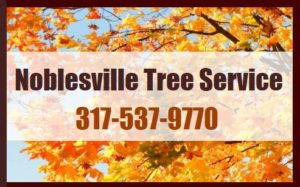After the performance of last night’s lightning storm, it is expected to have some concerns about your landscaping trees. Trees can be struck by lightning and extensively damaged; they can split in half, catch fire, or even explode! If you are concerned about your tree’s vulnerability to storm damage such as lightning strikes, continue reading to learn what you need to know to protect your trees and your property.

Noblesville Tree Service 317-537-9770
Why Trees Get Struck
When a storm occurs, lightning strikes in the path of least resistance in order to reach the ground. Water is a better conductor of electricity than air, so it makes sense that lightning would be attracted to trees since they are full of water and sap. The moisture inside trees makes them a direct target for lightning, and the worst possible place to take cover in a storm.
Most often, lightning-struck trees are damaged to the point of decline since their root systems are fried from the electrical current; so they eventually die. Other trees experience lighter amounts of damage, but never fully recover, and some avoid damage altogether after a direct strike. Trees that manage to escape lightning damage are usually those soaked from heavy amounts of rain, causing the lightning to quickly flash over the bark without leaving behind any scarring or structural injury.
Protecting Trees From Lightning
Choosing tree species that are less prone to lightning strikes is an effective preventive method that works well. Tree species like oak, elm, pine, tulip, cottonwood, ash, maple, sycamore, hemlock and spruce, are more susceptible to lightning strikes since they retain more moisture and sap in their wood. If a tree on your property is damaged by lightning, it likely will need some corrective pruning; if it is dead as a result of the strike, it will likely need to be removed. Common treatments for lightning-damaged trees include water management, bark repair, pruning, fertilization, pest control, and monitoring.
Lightning Protection Systems
For areas that are highly susceptible to lightning strikes, such as trees located within 25 feet of buildings and housing, homeowners can install a lightning protection system to help prevent landscape damages. These systems are designed to not attract lightning by dissipating the electrical charge before it can build to high levels. Although they are generally expensive and require a lot of labor and materials, their performance values are widely supported by many who have had them installed. Talk to a local arborist or Noblesville tree service for help with tree care protection plans. They can give you the best advice for your particular landscaping and tree species.
Noblesville Tree Service

Tree Service Noblesville 317-537-9770


